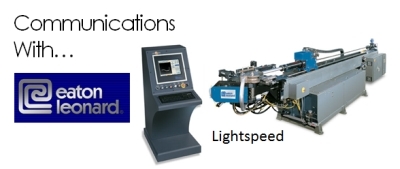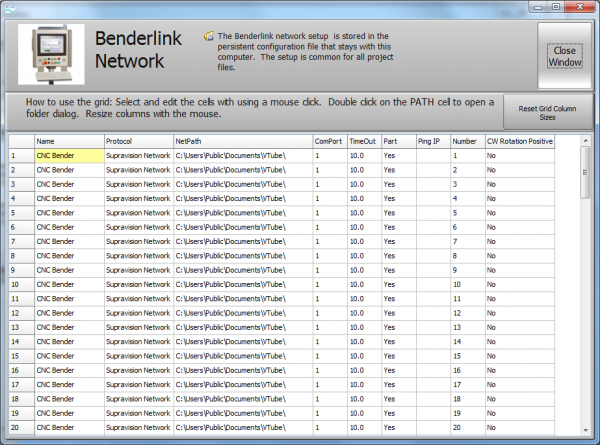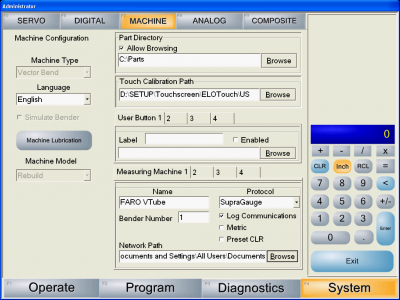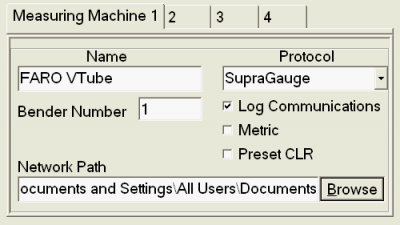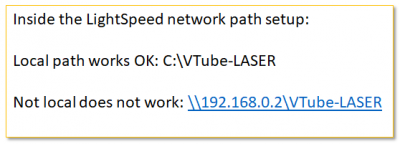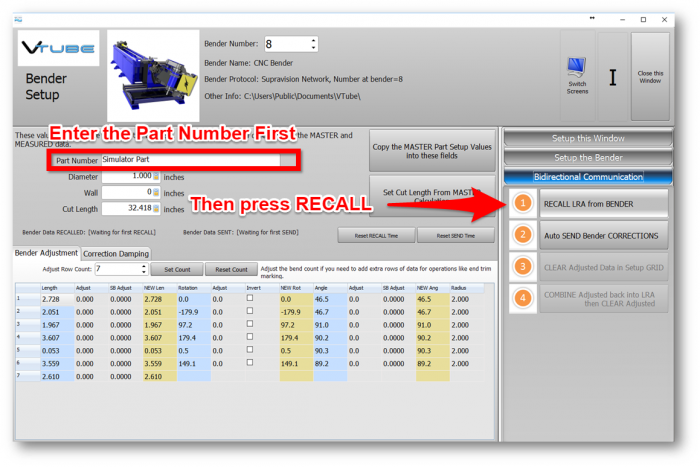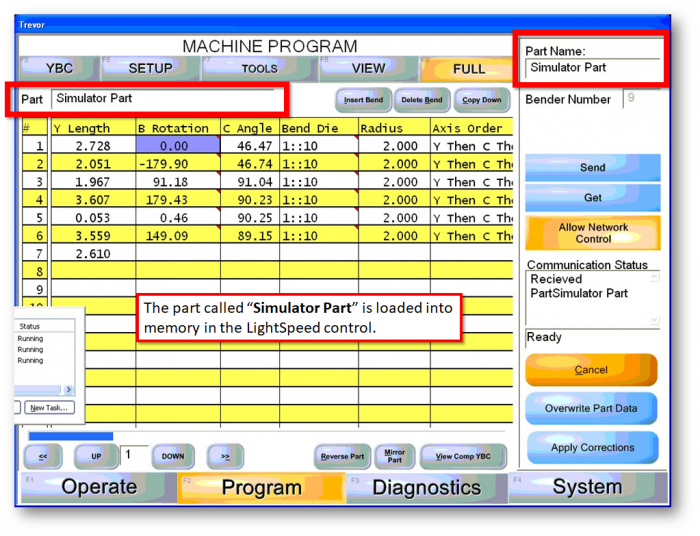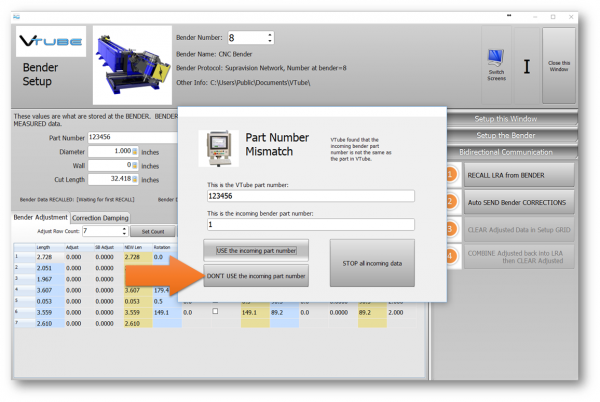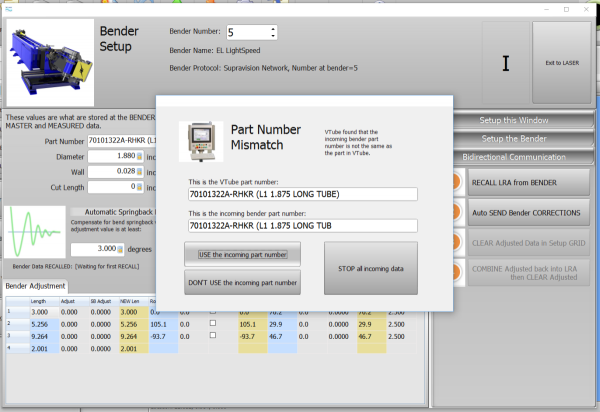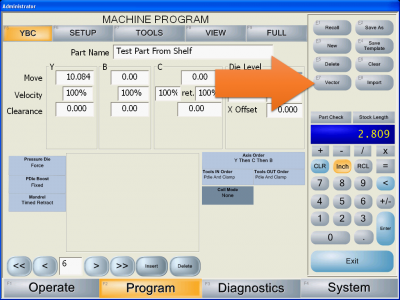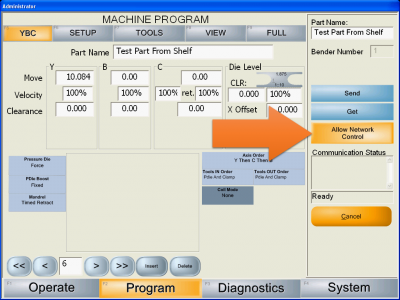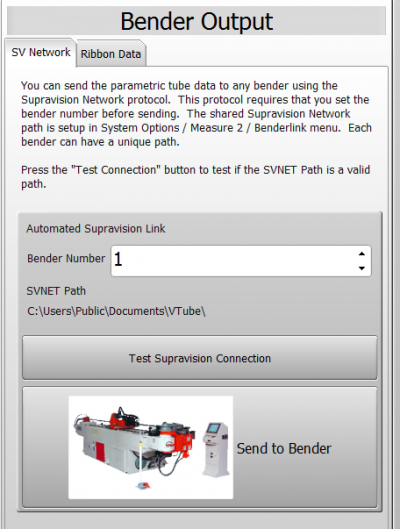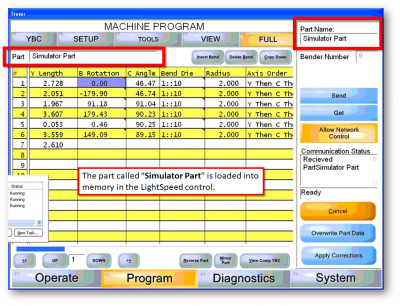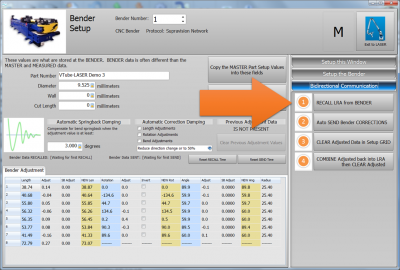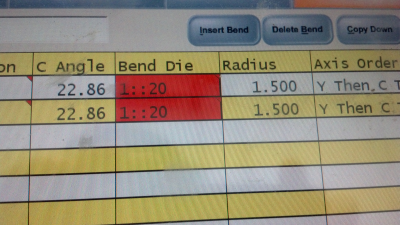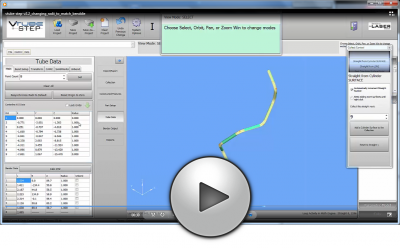Difference between revisions of "Eaton Leonard Lightspeed Communications Setup"
(→STEP 2: Device Config / Machine Menu) |
|||
| (191 intermediate revisions by one user not shown) | |||
| Line 11: | Line 11: | ||
<tr> | <tr> | ||
<td width="200"> | <td width="200"> | ||
| − | * Back to [[Eaton Leonard]] | + | * Back to the Eaton Leonard [[Lightspeed]] page<br><br> |
| + | * Back to the general [[Eaton Leonard]] | ||
<br><br> | <br><br> | ||
</td> | </td> | ||
| Line 20: | Line 21: | ||
</table> | </table> | ||
| − | + | __NOTOC__ | |
| + | <br><br> | ||
| − | == | + | ==How to Setup VTube for Communications with Supravision Network== |
<table> | <table> | ||
| + | <tr> | ||
| + | <td width="300"> | ||
| + | The VTube Benderlink setup grid needs to be properly configured to for Supravision Network communications before it will work with the LightSpeed.<br><br> | ||
| + | The instructions that follow assume that VTube has been setup using the instructions.<br> | ||
| + | <br> | ||
| + | See '''[[Setup VTube for Supravision Network Communication]]''' for detailed instructions on how configure VTube for communications. | ||
| + | </td> | ||
| + | <td> | ||
| + | [[image:vtube_benderlinkgrid.png|600px]]<br><br> | ||
| + | </td> | ||
| + | </tr> | ||
| + | </table> | ||
| + | |||
| + | ==How To Setup Eaton Leonard LIGHTSPEED for Communications with VTube-LASER== | ||
| + | |||
| + | <table> | ||
<tr> | <tr> | ||
<td width="300"> | <td width="300"> | ||
| − | Change to the Systems menu. If you are not running the operator station as an administrator, then press SECURITY and enter the administrator code. (The default code is "123".)<br><br> | + | Use these steps to set up a connection to LightSpeeds with our [[VTube-LASER]], [[VTube-STEP]], and [[Benderlink]] software packages. All of our software packages are equipped with the Supravision Network protocol - which is a protocol LightSpeed uses to communicate with VTube-LASER. |
| + | </td> | ||
| + | </table> | ||
| + | |||
| + | ===STEP 1: System Menu and Administrative Control=== | ||
| + | <table> | ||
| + | |||
| + | <tr> | ||
| + | <td width="300"> | ||
| + | Change to the Systems menu. If you are not running the operator station as an administrator, then press SECURITY and enter the administrator code. (The default administrator code is "123" - but some customers will have changed this code.)<br><br> | ||
Press the DEVICE CONFIG button. | Press the DEVICE CONFIG button. | ||
| Line 38: | Line 65: | ||
</table> | </table> | ||
| − | |||
===STEP 2: Device Config / Machine Menu=== | ===STEP 2: Device Config / Machine Menu=== | ||
| Line 49: | Line 75: | ||
Select a Measure Machine tab. LightSpeed can store four simultaneous measuring center setups for connection to multiple measuring centers.<br><br> | Select a Measure Machine tab. LightSpeed can store four simultaneous measuring center setups for connection to multiple measuring centers.<br><br> | ||
| − | * NAME: The | + | * '''NAME''': The name value has no effect on the protocol. However, you can give the setup a name here.<br><br> |
| − | * PROTOCOL: | + | * '''PROTOCOL''': For communications with our software, select the SupraGauge protocol.<br><br> |
| − | * BENDER NUMBER: Set the bender to | + | * '''BENDER NUMBER''': Set the bender to a unique integer number. This is very important if you have multiple benders that share the same network location for transfer of data files.<br><br>The bender number allows each bender to understand if the data files dropped in the shared path are its responsibility or another bender's.<br><br>The original SV protocol can handle bender numbers from 1 to 99. VTube can go higher if necessary.<br><br> |
| − | * CHECKBOX OPTIONS: Select any of the checkbox options that you want to enable. <br><br> | + | * '''CHECKBOX OPTIONS''': Select any of the checkbox options that you want to enable. <br><br> |
| − | ** LOG: To log activity as it occurs<br><br> | + | **'''1 - LOG''': To log activity as it occurs<br><br> |
| − | ** METRIC: To make all linear data communicate in Millimeters rather than the default Inches<br><br> | + | **'''2 - METRIC''': To make all linear data communicate in Millimeters rather than the default Inches<br><br> |
| − | ** PRESET CLR: To ignore any incoming Centerline Radius data.<br><br> | + | **'''3 - PRESET CLR''': To ignore any incoming Centerline Radius data. If you leave this disabled, then you will probably need to setup the CLR after LightSpeed receives a new part file from the measuring center.<br><br> |
| − | * NETWORK PATH: Set the Network Path to a location on the network that allows read/write access. This is the path where all machines and measuring centers will drop and pickup command files using the Supravision Network protocol. | + | * '''NETWORK PATH''': Set the Network Path to a location on the network that allows read/write access. This is the path where all machines and measuring centers will drop and pickup command files using the Supravision Network protocol.<br><br> |
</td> | </td> | ||
| Line 64: | Line 90: | ||
</td> | </td> | ||
</tr> | </tr> | ||
| + | |||
| + | |||
| + | <tr> | ||
| + | <td width="300" valign=top> | ||
| + | |||
| + | ====IMPORTANT NOTE ABOUT WHERE TO PUT THE NETWORK PATH==== | ||
| + | Use only a path that is pointing to a location on the LightSpeed control local hard drive. Then link the VTube-LASER computer to that path through the network.'''<br><br> | ||
| + | It is our experience that LightSpeed controls will often only communicate using the Supravision Network protocol if the path is set to the LightSpeed's local hard drive.<br><br>Either LightSpeed cannot handle a UNC path (with slashes like \\192.168.0.2\VTube-LASER) or it cannot handle slightly delayed network speeds.<br><br>However, sharing the LightSpeed drive and using it as the shared path works well.<br><br> | ||
| + | |||
| + | </td> | ||
| + | <td valign=top> | ||
| + | [[image:LightSpeed Path Limitations.png|400px]] | ||
| + | </td> | ||
| + | </tr> | ||
| + | |||
| + | |||
| + | </table> | ||
| + | <br><br> | ||
| + | |||
| + | ==RULES for EATON LEONARD LIGHTSPEED COMMUNICATION== | ||
| + | |||
| + | |||
| + | ===LightSpeed Controls Require That VTube-LASER uses the SAME PART NUMBER for RECALL=== | ||
| + | |||
| + | <table> | ||
| + | |||
| + | <tr> | ||
| + | <td width="300" valign=top> | ||
| + | '''The Part Number is very important when VTube-LASER performs a bender data RECALL. It must be set first before you press RECALL.'''<br><br> | ||
| + | During RECALL the Eaton Leonard LightSpeed returns data from the FILE in the control based on the part number you entered in VTube-LASER's Bender Setup window.'''<br><br> | ||
| + | For example, if you are running "Simulator Part" (see the image on the right), and want to recall the data you see on the screen in the LightSpeed controls, then it is important to type in the exact part number in VTube-LASER's Bender Setup screen before recalling.<br><br> | ||
| + | ====What Happens When You Recall a Different Part Number==== | ||
| + | If you recall part "12345" from VTube-LASER, then the LightSpeed will search for part "12345" in the part database on the disk - and return the data for "12345" from storage if it is found. If it isn't found, then LightSpeed will just let the connection timeout.<br><br> | ||
| + | ====What Happens When You SEND a Different Part Number==== | ||
| + | During SEND from VTube-LASER to the LightSpeed, if the part number is different than the one that is running in memory, then the data will overwrite the data in the FILE and not the one in the control's memory. Please be careful to use the correct Part Number during communications for both SEND and RECALL. | ||
| + | <br><br> | ||
| + | </td> | ||
| + | |||
| + | <td> | ||
| + | [[image:LightSpeed ProgramScreen ReceivedData in VTL Bender Setup.png|700px]]<br><br> | ||
| + | [[image:LightSpeed_ProgramScreen_ReceivedData2.png|700px]]<br><br> | ||
| + | |||
| + | </td> | ||
| + | </tr> | ||
| + | |||
| + | </table> | ||
| + | <br><br> | ||
| + | |||
| + | ===Some LightSpeed Controls Always Return A Part Number With the First Character Only=== | ||
| + | |||
| + | <table> | ||
| + | |||
| + | <tr> | ||
| + | <td width="300"> | ||
| + | This is a bug in some versions of LightSpeed controls - but it does not create a problem for VTube-LASER. If you recall '''123456', then LightSpeed will answer with the data in 123456, but always truncate the part number to "1" alone.<br><br> | ||
| + | If this happens during a RECALL, then just tell VTube-LASER to IGNORE the incoming part number every time. (The fact that the LightSpeed answered means that you are using a part number that already exists on the LightSpeed control.) | ||
| + | <br><br> | ||
| + | </td> | ||
| + | |||
| + | <td> | ||
| + | [[image:VTL reaction to LightSpeed Truncating the Part Number.png|600px]] | ||
| + | </td> | ||
| + | </tr> | ||
| + | |||
| + | </table> | ||
| + | <br><br> | ||
| + | |||
| + | ===LightSpeed Part Numbers for Communication are Limited to 33 Characters=== | ||
| + | |||
| + | <table> | ||
| + | |||
| + | <tr> | ||
| + | <td width="300"> | ||
| + | The part number character length can be greater than 33 characters in both the LightSpeed and VTube-LASER. However, the part number length is truncated to 33 characters maximum by the LightSpeed <u>during communications</u>.<br><br> | ||
| + | See the example RECALL on the right. The incoming part number is truncated in length.<br><br> | ||
| + | This is a limitation on the LightSpeed side of the connection. VTube has no control over this limitation. You might want to restrict your part names so that they have less than 33 characters if you want to communicate with VTube.<br><br> | ||
| + | </td> | ||
| + | |||
| + | <td> | ||
| + | [[image:vtube-laser_v2.7_EL_LightSpeed_PartNumber_Character_Count_Limitation.png|600px]] | ||
| + | </td> | ||
| + | </tr> | ||
| + | |||
| + | </table> | ||
| + | <br><br> | ||
| + | |||
| + | ==VTube-STEP Communications Test With LightSpeed== | ||
| + | |||
| + | VTube-STEP is the version of VTube that allows you to send data from a model to a bender. <br> (VTube-LASER can SEND and RECALL. See the VTube-LASER section below.) This section is for testing the LightSpeed control with with VTube-STEP.<br><br> | ||
| + | |||
| + | In order to communicate with the LightSpeed control, it's necessary to switch on remote communications in the control in the user interface.<br><br> | ||
| + | |||
| + | ===STEP 1: Exit AUTO Mode=== | ||
| + | <table> | ||
| + | |||
| + | <tr> | ||
| + | <td width="300" valign=top> | ||
| + | Be sure to exit AUTO mode if that is the mode it is currently in. LightSpeed does not communicate if it is in AUTO mode. | ||
| + | </td> | ||
| + | <td> | ||
| + | </td> | ||
| + | </tr> | ||
| + | |||
| + | </table> | ||
| + | |||
| + | ===STEP 2: Enter the Vector Menu=== | ||
| + | <table> | ||
| + | |||
| + | <tr> | ||
| + | <td width="300" valign=top> | ||
| + | Click on the "Vector" button on the right side of the screen.<br><br> | ||
| + | </td> | ||
| + | <td> | ||
| + | [[image:LightSpeed_ProgramScreen_VectorButton.png|400px]] | ||
| + | </td> | ||
| + | </tr> | ||
| + | |||
| + | </table> | ||
| + | |||
| + | |||
| + | ===STEP 3: Choose the VMM for VTube=== | ||
| + | <table> | ||
| + | |||
| + | <tr> | ||
| + | <td width="300" valign=top> | ||
| + | Newer versions of LightSpeed let you choose which measuring center to communicate with.<br><br> | ||
| + | Choose the VTube option. | ||
| + | </td> | ||
| + | <td> | ||
| + | [[image:LightSpeed_VMM_Choice.png|400px]] | ||
| + | </td> | ||
| + | </tr> | ||
| + | |||
| + | </table> | ||
| + | |||
| + | ===STEP 4: Allow Network Control=== | ||
| + | <table> | ||
| + | |||
| + | <tr> | ||
| + | <td width="300" valign=top> | ||
| + | In the VECTOR menu, press the "Allow Network Control" button until it turns orange. (Orange indicates that it is toggled on.)<br><br> | ||
| + | </td> | ||
| + | <td valign=top> | ||
| + | [[image:LightSpeed_ProgramScreen_AllowNetworkControl.png|400px]]<br><br> | ||
| + | </td> | ||
| + | </tr> | ||
| + | |||
| + | </table> | ||
| + | <br><br> | ||
| + | |||
| + | ===STEP 5: SEND a Part from the VTube-STEP=== | ||
| + | <table width=800> | ||
| + | <tr valign=top> | ||
| + | <td width=300> | ||
| + | If a part is not in VTube already, then load one in before you continue.<br><br> | ||
| + | Use the [[VTube-STEP]] Bender Output menu to send new part data to a bender using Supravision Network protocol.<br><br> | ||
| + | |||
| + | <br><br> | ||
| + | Go to the SV Network tab and choose the bender number. This will use the Benderlink setup in System Options to control the SVNET path.<br><br> | ||
| + | |||
| + | * The Supravision Network protocol uses a bender number (from 1 to 99) to indicate which bender should pickup and use the Supravision file that is being saved by VTube-STEP to the file path in the network box. Use whatever you have programmed into the EL LightSpeed setup for bender number.<br><br> | ||
| + | * The LightSpeed uses the Part Number value from the VTube PART SETUP menu to create a part file if it does not exist on the LightSpeed hard drive. If it does exist, then the data can be merged into the existing file with the same part number. | ||
| + | |||
| + | </td> | ||
| + | <td> | ||
| + | [[image:vtube-step_v2.2_svnet.png|400px]]<br><br> | ||
| + | </td> | ||
| + | |||
| + | </tr> | ||
| + | </table> | ||
| + | <br><br> | ||
| + | |||
| + | ===STEP 6: Observe the LightSpeed Communications Status Box=== | ||
| + | <table> | ||
| + | |||
| + | <tr> | ||
| + | <td width="300" valign=top> | ||
| + | The Communications Status box in the LightSpeed Vector menu should show activity - like that the incoming file was saved.<br><br>You will also see the options of Overwriting the part data, or Importing the YBC data only. Overwriting the part data will allow the new data to completely overwrite the part in memory. Pressing the YBC data only will change only the YBC data in memory with the incoming data.<br><br> | ||
| + | For setting up a new part, you can press overwrite. For corrections you can press YBC data only.<br><br> | ||
| + | In this test, press Overwrite Part Data.<br><br> | ||
| + | If you press Overwrite the Part Data, then LightSpeed will clear the current setup and clear the Tools. A tool set will need to be recalled to clear the red cells in the ALL page Bend Die column. | ||
| + | </td> | ||
| + | <td valign=top> | ||
| + | [[image:LightSpeed_ProgramScreen_ReceivedData2.png|400px]]<br><br> | ||
| + | </td> | ||
| + | </tr> | ||
| + | |||
| + | </table> | ||
| + | <br><br> | ||
| + | |||
| + | ==VTube-LASER Communications Test With LightSpeed== | ||
| + | |||
| + | VTube-LASER is the version of VTube that communicates with a FARO arm in order to measure tubes and correct benders. <br> It's communications capabilities are more sophisticated than VTube-STEP. VTube-STEP can send data to the bender. VTube-LASER can SEND and RECALL. <br> This section is for testingthe LightSpeed control with with VTube-LASER.<br><br> | ||
| + | |||
| + | In order to communicate with the LightSpeed control, it's necessary to switch on remote communications in the control in the user interface.<br><br> | ||
| + | |||
| + | ===STEP 1: Exit AUTO Mode=== | ||
| + | <table> | ||
| + | |||
| + | <tr> | ||
| + | <td width="300" valign=top> | ||
| + | Be sure to exit AUTO mode if that is the mode it is currently in. LightSpeed does not communicate if it is in AUTO mode. | ||
| + | </td> | ||
| + | <td> | ||
| + | </td> | ||
| + | </tr> | ||
| + | |||
| + | </table> | ||
| + | |||
| + | ===STEP 2: Enter the Vector Menu=== | ||
| + | <table> | ||
| + | |||
| + | <tr> | ||
| + | <td width="300" valign=top> | ||
| + | Click on the "Vector" button on the right side of the screen.<br><br> | ||
| + | </td> | ||
| + | <td> | ||
| + | [[image:LightSpeed_ProgramScreen_VectorButton.png|400px]] | ||
| + | </td> | ||
| + | </tr> | ||
| + | |||
| + | </table> | ||
| + | |||
| + | |||
| + | ===STEP 3: Choose the VMM for VTube=== | ||
| + | <table> | ||
| + | |||
| + | <tr> | ||
| + | <td width="300" valign=top> | ||
| + | Newer versions of LightSpeed let you choose which measuring center to communicate with.<br><br> | ||
| + | Choose the VTube option. | ||
| + | </td> | ||
| + | <td> | ||
| + | [[image:LightSpeed_VMM_Choice.png|400px]] | ||
| + | </td> | ||
| + | </tr> | ||
| + | |||
| + | </table> | ||
| + | |||
| + | ===STEP 4: Allow Network Control=== | ||
| + | <table> | ||
| + | |||
| + | <tr> | ||
| + | <td width="300" valign=top> | ||
| + | In the VECTOR menu, press the "Allow Network Control" button until it turns orange. (Orange indicates that it is toggled on.)<br><br> | ||
| + | </td> | ||
| + | <td valign=top> | ||
| + | [[image:LightSpeed_ProgramScreen_AllowNetworkControl.png|400px]]<br><br> | ||
| + | </td> | ||
| + | </tr> | ||
| + | |||
| + | </table> | ||
| + | <br><br> | ||
| + | |||
| + | ===STEP 5: SEND a Part from the VTube-LASER=== | ||
| + | <table> | ||
| + | |||
| + | <tr> | ||
| + | <td width="300" valign=top> | ||
| + | From the measuring center, send a part to the LightSpeed. (This assumes that the connection has been made and that the SVNET protcol is being used, and that the appropriate bender number is used at the measuring center.<br><br> | ||
| + | |||
| + | The screen on the right shows an example Bender Setup screen in [[VTube-LASER]] for communication.<br><br> | ||
| + | To send new data, choose the bender number, set the Part Number (if it is not, enter the "Bender Setup" menu, and press the AUTO SEND button.<br><br> | ||
| + | '''Keep in mind that the PART NUMBER value in VTube is the name that will be used by the LightSpeed to save the part data that it received.''' | ||
| + | </td> | ||
| + | <td valign=top> | ||
| + | [[image:vtube-laser_v2.2_bendersetup_sendbluecolumns.png|400px]]<br><br> | ||
| + | </td> | ||
| + | </tr> | ||
| + | |||
| + | </table> | ||
| + | <br><br> | ||
| + | |||
| + | ===STEP 6: Observe the LightSpeed Communications Status Box=== | ||
| + | <table> | ||
| + | |||
| + | <tr> | ||
| + | <td width="300" valign=top> | ||
| + | The Communications Status box in the LightSpeed Vector menu should show activity - like that the incoming file was saved.<br><br>You will also see the options of Overwriting the part data, or Importing the YBC data only. Overwriting the part data will allow the new data to completely overwrite the part in memory. Pressing the YBC data only will change only the YBC data in memory with the incoming data.<br><br> | ||
| + | For setting up a new part, you can press overwrite. For corrections you can press YBC data only.<br><br> | ||
| + | In this test, press Overwrite Part Data.<br><br> | ||
| + | If you press Overwrite the Part Data, then LightSpeed will clear the current setup and clear the Tools. A tool set will need to be recalled to clear the red cells in the ALL page Bend Die column. | ||
| + | </td> | ||
| + | <td valign=top> | ||
| + | [[image:LightSpeed_ProgramScreen_ReceivedData2.png|400px]]<br><br> | ||
| + | </td> | ||
| + | </tr> | ||
| + | |||
| + | </table> | ||
| + | <br><br> | ||
| + | |||
| + | ===STEP 7: Perform a RECALL at VTube-LASER=== | ||
| + | <table> | ||
| + | |||
| + | <tr> | ||
| + | <td width="300" valign=top> | ||
| + | Change any value in the YBC data. Make the value change easily recognizable for when we recall the data in VTube-LASER.<br><br> | ||
| + | Now, at VTube-LASER press RECALL. LightSpeed should answer VTube-LASER with the new data in the blue columns.<br><br> | ||
| + | If the new values are displayed in the blue LRA columns, then the communication was successful.<br><br> | ||
| + | '''(Note: VTube-STEP cannot perform a RECALL from the bender. Only VTube-LASER can RECALL data.)''' | ||
| + | </td> | ||
| + | <td valign=top> | ||
| + | [[image:vtube-laser_v2.2_bendersetup_recall_lra_from_bender.png|400px]]<br><br> | ||
| + | </td> | ||
| + | </tr> | ||
| + | |||
| + | </table> | ||
| + | <br><br> | ||
| + | |||
| + | ==Solving LightSpeed Bend Die / Incoming RADIUS Mismatch Issue== | ||
| + | |||
| + | <table> | ||
| + | |||
| + | <tr> | ||
| + | <td width="300"> | ||
| + | If you send a part to the LightSpeed that has dies that do not match the current die setup, then the Bend Die columns in the VIEW page will turn red - indicating a problem.<br><br> | ||
| + | The key to fixing the problem is to be sure the incoming radius eventually matches the TOOL page die radius value. | ||
| + | </td> | ||
| + | |||
| + | <td> | ||
| + | [[image:lightspeed_red_benddie_cells.png|400px]] | ||
| + | </td> | ||
| + | </tr> | ||
| + | |||
| + | </table> | ||
| + | |||
| + | ===SOLUTION 1: Change the Radius Values in VTube before Sending Data=== | ||
| + | <table> | ||
| + | |||
| + | <tr> | ||
| + | <td width="300" valign=top> | ||
| + | It's easy to change the radius values for a tube model before sending the data to the bender. In the video example, you will see a radius value of 1". However, in the Eaton Leonard LightSpeed, the die centerline radius is 1.125". So, just before sending data to the bender, we change the radius to match the bend die on the bender. This does not change the shape of the tube in space. It only changes the lengths between bends.<br><br> | ||
| + | ''Click on the image to view the video.''</td> | ||
| + | <td> | ||
| + | [[image:vtube-step_v2_2_change_radii_then_transfer_to_bender_video.png|400px|link=http://www.advancedtubular.com/vtube-step/vtube-step-v2.2_changing_radii_to_match_benddie.mp4]] | ||
| + | |||
| + | </td> | ||
| + | </tr> | ||
| + | </table> | ||
| + | |||
| + | ===SOLUTION 2: Be sure the TOOLS Page Is Setup With Non Zero Values=== | ||
| + | <table> | ||
| + | <tr> | ||
| + | <td width="300" valign=top> | ||
| + | When you clear a part, the process also can clear the tool page so that all the values are reset to zero. The image on the right shows what happens after clear of a program in the LightSpeed<br><br> | ||
| + | The LightSpeed control needs these values to be filled out in order to work properly.<br><br> | ||
| + | So you can either enter data manually, or load a good Tool setup into this page.</td> | ||
| + | <td> | ||
| + | [[image:lightspeed_toolpage_zeros.png|400px]]<br> | ||
| + | [[image:lightspeed_tools_page_setup.png|400px]] | ||
| + | </td> | ||
| + | </tr> | ||
| + | </table> | ||
| + | |||
| + | ===SOLUTION 3: Be sure the YBC Page CENTERLINE RADIUS Values Match the TOOL Page Values=== | ||
| + | <table> | ||
| + | <tr valign=top> | ||
| + | <td width="300" valign=top> | ||
| + | Also, it is important that the centerline radius value in the YBC page matches the radius value in the TOOL page.<br><br> | ||
| + | In the YBC page, be sure that the radius value in the radius box matches the radius value at the top of the die icon.<br><br> | ||
| + | In the image example, the centerline radius value is ZERO, but the tools are setup for 1.875". This will cause the Bend Die value in the corresponding cell of the FULL view to turn red.<br><br> | ||
| + | [[image:lightspeed_ybcpage_clr_zero_closeup.png|300px]] | ||
| + | |||
| + | </td> | ||
| + | <td> | ||
| + | [[image:lightspeed_ybcpage_clr_zero.png|400px]] | ||
| + | </td> | ||
| + | </tr> | ||
| + | </table> | ||
| + | |||
| + | |||
| + | ==Other Pages== | ||
| + | |||
| + | <table> | ||
<tr> | <tr> | ||
<td width="200"> | <td width="200"> | ||
| + | * Back to the Eaton Leonard [[Lightspeed]] page | ||
* Back to [[Eaton Leonard]] | * Back to [[Eaton Leonard]] | ||
<br><br> | <br><br> | ||
Latest revision as of 13:42, 19 April 2023
|
This document outlines the basic communications setup for a Lightspeed control. |
|
|
How to Setup VTube for Communications with Supravision Network
|
The VTube Benderlink setup grid needs to be properly configured to for Supravision Network communications before it will work with the LightSpeed. |
How To Setup Eaton Leonard LIGHTSPEED for Communications with VTube-LASER
|
Use these steps to set up a connection to LightSpeeds with our VTube-LASER, VTube-STEP, and Benderlink software packages. All of our software packages are equipped with the Supravision Network protocol - which is a protocol LightSpeed uses to communicate with VTube-LASER. |
STEP 1: System Menu and Administrative Control
|
Change to the Systems menu. If you are not running the operator station as an administrator, then press SECURITY and enter the administrator code. (The default administrator code is "123" - but some customers will have changed this code.) Press the DEVICE CONFIG button. |
STEP 2: Device Config / Machine Menu
|
In DEVICE CONFIG, enter the MACHINE menu. Select a Measure Machine tab. LightSpeed can store four simultaneous measuring center setups for connection to multiple measuring centers.
|
|
IMPORTANT NOTE ABOUT WHERE TO PUT THE NETWORK PATHUse only a path that is pointing to a location on the LightSpeed control local hard drive. Then link the VTube-LASER computer to that path through the network. |
RULES for EATON LEONARD LIGHTSPEED COMMUNICATION
LightSpeed Controls Require That VTube-LASER uses the SAME PART NUMBER for RECALL
|
The Part Number is very important when VTube-LASER performs a bender data RECALL. It must be set first before you press RECALL. What Happens When You Recall a Different Part NumberIf you recall part "12345" from VTube-LASER, then the LightSpeed will search for part "12345" in the part database on the disk - and return the data for "12345" from storage if it is found. If it isn't found, then LightSpeed will just let the connection timeout. What Happens When You SEND a Different Part NumberDuring SEND from VTube-LASER to the LightSpeed, if the part number is different than the one that is running in memory, then the data will overwrite the data in the FILE and not the one in the control's memory. Please be careful to use the correct Part Number during communications for both SEND and RECALL.
|
Some LightSpeed Controls Always Return A Part Number With the First Character Only
|
This is a bug in some versions of LightSpeed controls - but it does not create a problem for VTube-LASER. If you recall 123456', then LightSpeed will answer with the data in 123456, but always truncate the part number to "1" alone. |
LightSpeed Part Numbers for Communication are Limited to 33 Characters
|
The part number character length can be greater than 33 characters in both the LightSpeed and VTube-LASER. However, the part number length is truncated to 33 characters maximum by the LightSpeed during communications. |
VTube-STEP Communications Test With LightSpeed
VTube-STEP is the version of VTube that allows you to send data from a model to a bender.
(VTube-LASER can SEND and RECALL. See the VTube-LASER section below.) This section is for testing the LightSpeed control with with VTube-STEP.
In order to communicate with the LightSpeed control, it's necessary to switch on remote communications in the control in the user interface.
STEP 1: Exit AUTO Mode
|
Be sure to exit AUTO mode if that is the mode it is currently in. LightSpeed does not communicate if it is in AUTO mode. |
STEP 2: Enter the Vector Menu
|
Click on the "Vector" button on the right side of the screen. |
STEP 3: Choose the VMM for VTube
|
Newer versions of LightSpeed let you choose which measuring center to communicate with. |
STEP 4: Allow Network Control
|
In the VECTOR menu, press the "Allow Network Control" button until it turns orange. (Orange indicates that it is toggled on.) |
STEP 5: SEND a Part from the VTube-STEP
|
If a part is not in VTube already, then load one in before you continue.
|
STEP 6: Observe the LightSpeed Communications Status Box
|
The Communications Status box in the LightSpeed Vector menu should show activity - like that the incoming file was saved. |
VTube-LASER Communications Test With LightSpeed
VTube-LASER is the version of VTube that communicates with a FARO arm in order to measure tubes and correct benders.
It's communications capabilities are more sophisticated than VTube-STEP. VTube-STEP can send data to the bender. VTube-LASER can SEND and RECALL.
This section is for testingthe LightSpeed control with with VTube-LASER.
In order to communicate with the LightSpeed control, it's necessary to switch on remote communications in the control in the user interface.
STEP 1: Exit AUTO Mode
|
Be sure to exit AUTO mode if that is the mode it is currently in. LightSpeed does not communicate if it is in AUTO mode. |
STEP 2: Enter the Vector Menu
|
Click on the "Vector" button on the right side of the screen. |
STEP 3: Choose the VMM for VTube
|
Newer versions of LightSpeed let you choose which measuring center to communicate with. |
STEP 4: Allow Network Control
|
In the VECTOR menu, press the "Allow Network Control" button until it turns orange. (Orange indicates that it is toggled on.) |
STEP 5: SEND a Part from the VTube-LASER
|
From the measuring center, send a part to the LightSpeed. (This assumes that the connection has been made and that the SVNET protcol is being used, and that the appropriate bender number is used at the measuring center. The screen on the right shows an example Bender Setup screen in VTube-LASER for communication. |
STEP 6: Observe the LightSpeed Communications Status Box
|
The Communications Status box in the LightSpeed Vector menu should show activity - like that the incoming file was saved. |
STEP 7: Perform a RECALL at VTube-LASER
|
Change any value in the YBC data. Make the value change easily recognizable for when we recall the data in VTube-LASER. |
Solving LightSpeed Bend Die / Incoming RADIUS Mismatch Issue
|
If you send a part to the LightSpeed that has dies that do not match the current die setup, then the Bend Die columns in the VIEW page will turn red - indicating a problem. |
SOLUTION 1: Change the Radius Values in VTube before Sending Data
|
It's easy to change the radius values for a tube model before sending the data to the bender. In the video example, you will see a radius value of 1". However, in the Eaton Leonard LightSpeed, the die centerline radius is 1.125". So, just before sending data to the bender, we change the radius to match the bend die on the bender. This does not change the shape of the tube in space. It only changes the lengths between bends. |
SOLUTION 2: Be sure the TOOLS Page Is Setup With Non Zero Values
|
When you clear a part, the process also can clear the tool page so that all the values are reset to zero. The image on the right shows what happens after clear of a program in the LightSpeed |
SOLUTION 3: Be sure the YBC Page CENTERLINE RADIUS Values Match the TOOL Page Values
Other Pages
|
